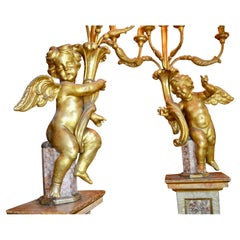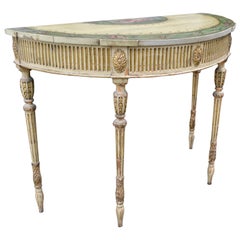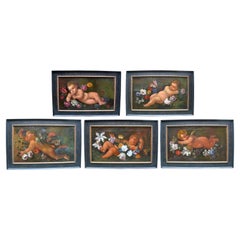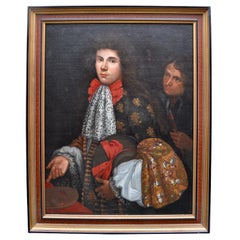Video Loading
Want more images or videos?
Request additional images or videos from the seller
1 of 22
Complete Set of G. Ottaviani’s 18thC Engravings of Raphael’s Vatican Loggia
$32,000List Priceper set
About the Item
- Creator:Giovanni Ottaviani (Workshop/Studio)
- Dimensions:Height: 36 in (91.44 cm)Width: 34 in (86.36 cm)Depth: 2 in (5.08 cm)
- Sold As:Set of 13
- Style:Renaissance (In the Style Of)
- Materials and Techniques:
- Place of Origin:
- Period:1770-1779
- Date of Manufacture:1770
- Condition:Wear consistent with age and use. Minor fading. Some age related warping of the parchment paper.
- Seller Location:Vancouver, CA
- Reference Number:1stDibs: LU4631214574571
About the Seller
4.9
Vetted Professional Seller
Every seller passes strict standards for authenticity and reliability
Established in 1981
1stDibs seller since 2019
164 sales on 1stDibs
Typical response time: 1 hour
Authenticity Guarantee
In the unlikely event there’s an issue with an item’s authenticity, contact us within 1 year for a full refund. DetailsMoney-Back Guarantee
If your item is not as described, is damaged in transit, or does not arrive, contact us within 7 days for a full refund. Details24-Hour Cancellation
You have a 24-hour grace period in which to reconsider your purchase, with no questions asked.Vetted Professional Sellers
Our world-class sellers must adhere to strict standards for service and quality, maintaining the integrity of our listings.Price-Match Guarantee
If you find that a seller listed the same item for a lower price elsewhere, we’ll match it.Trusted Global Delivery
Our best-in-class carrier network provides specialized shipping options worldwide, including custom delivery.You May Also Like
Sèvres Porcelain Painting of Raphael's Madonna by Marcel Prunier
By Manufacture Nationale de Sèvres
Located in Lisbon, PT
This enamelled porcelain painting, inspired by Raphael’s iconic Madonna of the Chair (c. 1513), beautifully portrays the Christ Child embraced by Mary, with John the Baptist gazing r...
Category
20th Century French Renaissance Paintings
Materials
Porcelain, Scrap Wood
$1,839 Sale Price
28% Off
H 23.04 in W 19.3 in D 1.19 in
Hand-Coloured Scene from Cloister Vaults in the Raphael Loggias, Vatican, No. IV
Located in Kastrup, DK
Giovanni Ottaviani (Italy, 1735-1808)
Title: Scene from Cloister Vaults in the Raphael Loggias, Vatican
Large, exquisitely hand-coloured etching from the series Loggie di Rafaele ne...
Category
Antique Mid-18th Century Italian Other Paintings
Materials
Glass, Wood, Paper
$1,646
H 32.29 in W 26.78 in D 0.4 in
Scene from Cloister Vaults in the Raphael Loggias, Vatican, No. I
Located in Kastrup, DK
Giovanni Ottaviani (Italy, 1735-1808)
Title: Scene from Cloister Vaults in the Raphael Loggias, Vatican. No. I
Large, exquisitely hand-coloured etching from the series Loggie di Raf...
Category
Antique Late 18th Century Italian Other Prints
Materials
Glass, Wood, Paper
$1,646
H 26.78 in W 24.41 in D 0.4 in
Large Decorative Antique Print of a Fresco in the Vatican by Ottaviani, ca. 1775
By Giovanni Ottaviani
Located in Langweer, NL
Antique print titled 'Descendit de Monte Sinai, tenens duas Tabulas in manibus (..)'. Beautiful hand colored engraving of a fresco by Raphael. The title translates to 'Moses Descends from Mount Sinai'. This title does not seem to relate to the print, however, this print is part of a larger fresco...
Category
Antique Late 18th Century Italian Prints
Materials
Paper
$1,257 Sale Price
30% Off
H 16.34 in W 25.6 in D 0.02 in
The Complete Work of Raphael '1483-1520', 1st Ed
Located in valatie, NY
The Complete Work of Raphael, (1483-1520). Published in New York, Reynal & Company in association with William Morrow and Company, 1969. Raphael Sanzio, usually known by his first na...
Category
Vintage 1960s Books
Materials
Paper
18thc Oil Painted Capriccio Landscapes in the manner of Jean-Honoré Fragonard
By (After) Jean-Honoré Fragonard
Located in Savannah, GA
These two extraordinary 18th century oil on canvas paintings are done in the style of the French painter Jean-Honoré Fragonard whose late Rococo manner is renowned. Depicting landsca...
Category
Antique 1770s French Rococo Paintings
Materials
Canvas, Giltwood
$37,500 / set
H 31 in W 27 in D 2 in
Antique Oil Painting "Sacrifice to Minerva" Odoardo Vicinelli Letterfourie 18thC
Located in London, GB
A large antique oil on canvas painting entitled "Sacrifice to Minerva", circle of Francesco Solimena, attributed to Odoardo Vicinelli, dating from the mid 18th Century.
The painting depicts a man standing, behind an altar, shielding himself from a kindling fire. To the left of the altar is seated Minerva, in classical flowing white robes, surrounded by a crowd of people.
Francesco Solimena (4 October 1657 – 3 April 1747) was a prolific Italian painter of the Baroque era, one of an established family of painters and draughtsmen.
Verso: Title, describtion, inventory marks and later restoration stamp: Aitken Dott & Son, Edinburgh 15 July 1970.
Also bears an inscription attributing the painting to Odoardo Vicinelli:
Odoardo Vicinelli, scholar of Giovanni Maria Morandi, flourished about 1750
an excellent master of the Venetian and Roman Schools,
Provenance:
Formerly at Letterfourie, Morayshire, and by descent, through the Gordon family
Letterfourie House is a Georgian house in Moray Scotland, built by Robert Adam and completed in 1773 for Clan Gordon...
Category
Antique 1750s Italian Paintings
Materials
Canvas
$10,625
H 34.26 in W 66.15 in D 1.97 in
Early 18thc French Watercolor Portrait Seated Lady Drawing Castle in Background
Located in Savannah, GA
This charming early 1800s French Empire watercolor on paper features a fine lady seated upon a récamier. She wears a stylish high-waisted neoclassical dress and matching bonnet, note...
Category
Antique 1820s French Neoclassical Paintings
Materials
Glass, Giltwood, Paper
$796 Sale Price
20% Off
H 13.25 in W 11.25 in D 2 in
Vintage Pair of Hand Colored Engravings After Raphael “Le Loggie De Raffaello”
Located in West Palm Beach, FL
A fabulous pair of vintage hand colored engravings. Done in the manner of Raffaello’s “Le Loggie de Raffaello”. Purchased from the collection from The Breakers Hotel...
Category
Mid-20th Century Italian Renaissance Revival Paintings
Materials
Glass, Wood, Paper
$3,000 Sale Price / set
20% Off
H 55 in W 30 in D 1.75 in
Set of Four Hunting Engravings
Located in Cheshire, GB
Set off four hunting engravings, by R Ackermans, encased in ebonised frames.
Dimensions
Height 12 inches
Width 14 inches
Depth 1 inches.
Category
Antique 19th Century British Paintings
Materials
Paint
More From This Seller
View AllPair of Palatial Italian 18thC 5-Light Rococo Giltwood Cherub Torcheres
Located in Vancouver, British Columbia
This pair of magnificent torcheres are of the finest quality carved wood, gilding and faux marble painting. Each are comprised of a giltwood cherub or putto figure sitting on faux m...
Category
Antique Late 18th Century Italian Rococo Floor Lamps
Materials
Giltwood
Late 18thC Adam Period Demi-lune Console Table
By Robert Adam
Located in Vancouver, British Columbia
A fine quality late 18thC Adam period demi-lune console table; the entire table is painted a cream colour, the four shaped and tapered legs decorated with gilded wood fillets; the frieze is fluted all round with large gilded patterae above each leg. The painted top has an outer green banding decorated with garlands of flowers and gilding, the back of the painted top has a neoclassical fresco; depicting a classically draped winged Goddess surrounded by cherubs, flowers and scrolling, in the manner of Angelica Kaufmann...
Category
Antique Late 18th Century British Adam Style Demi-lune Tables
Materials
Pine
Set of Five Italian 18 Century Reclining or Flying Puttis Set Amidst Flowers
Located in Vancouver, British Columbia
This is an extremely rare and unique set of five oil on canvas paintings of naked puttis in either a reclining or flying pose surrounded by still life style flowers set against a bla...
Category
Antique Early 18th Century Italian Baroque Paintings
Materials
Canvas
19 Century English Portrait of an Aristocratic Gentleman in the Manner of Rubens
By Peter Paul Rubens
Located in Vancouver, British Columbia
A 19th C three quarter length portrait of an aristocratic gentleman with his personal valet shown behind him. The young man with flowing long hair is portrayed from the waist up and ...
Category
Antique Mid-19th Century English Renaissance Paintings
Materials
Canvas
18th Century Portrait of a French Aristocratic Gentleman
Located in Vancouver, British Columbia
A fine half length portrait of a powder wigged 18th century French aristocratic gentleman simply dressed in a brown waistcoat over an embroidered buttoned vest in which he has placed...
Category
Antique Late 18th Century French Louis XVI Paintings
Materials
Canvas
Pair of 18 Century Paintings of St Francis Xavier and St Carlo Borromeo
Located in Vancouver, British Columbia
A beautifully executed and rare complementary pair of oil on canvas paintings depicting two of the moist famous and important counter reformation catholic saints St Francis Xavier and St Carlo Borromeo shown in scenes of what the respective saints are mostly famous for. St Francis Xavier for the conversion to Christianity of many S. E Asian countries notably India and St Carlo Borromeo shown asking the Virgin Mary to intercede for the cessation of the terrible plague of 1576. The paintings are presented in refreshed gilded carved wooden frames and are unsigned.
St. Francis Xavier was born in Spanish Navarre in 1506 and in 1528, he met St. Ignatius of Loyola. He became one of the seven in 1534 who founded the Society of Jesus (Jesuit Order). In 1536, he left the University of Paris and joined St. Ignatius in Venice. He was ordained in 1537, and in 1540 after the Society was recognized by the Pope, he journeyed to the Far East. Francis Xavier first evangelized the Portuguese colony of Goa in India, then Travancore, Ceylon, Malacca, and the surrounding islands. From there he journeyed to Japan, where he gave Christianity such deep roots that it survived centuries of violent persecution. He died on Sancian Island in 1552, while he was seeking to penetrate into the great forbidden land of China.
Despite language problems, lack of funds, resistance from the Europeans as well as the natives, he persevered. St. Francis converted more people in his life than anyone since the Apostle St. Paul. He baptized over 3 million people, converted the entire town of Goa in India, and he labored in India, Pakistan, Bangladesh, Sri Lanka, Malaysia, Indonesia, Singapore, and Japan. He was truly a missionary par excellence.
St Carlo Borromeo (1538-1584), was a Cardinal of the Holy Roman Catholic Church and Archbishop of Milan from 1565 to 1583. He was described in the decree for his canonization, as “a man, even while the world smiles on him with the utmost flattery, he lives crucified to the world, spiritually, trampling earthly things, seeking continuously the things of heaven, emulating the life of the Angels on earth, in his thoughts and actions.
The plague began in the month of August that year. Milan was celebrating joyfully the arrival of Don John of Austria, on his way to Flanders, where he had been appointed governor. The city authorities were abuzz with excitement in their desire to bestow the highest honours on the Spanish prince, but Charles, who had been Archbishop of the diocese for six years, was following with concern the news coming from Trento, Verona and Mantua, where the plague had begun claiming victims. The first cases exploded in Milan on August 11th, right at the moment when Don John of Austria arrived. The victor of Lepanto, followed by the governor, Antonio de Guzmán y Zuñiga, departed the city, while Carlo Borromeo, who was in Lodi for the Bishop’s funeral, returned in haste.
Confusion and fear reigned in Milan and the Archbishop dedicated himself completely to assisting the sick and ordering public and private prayers. Dom Prosper Guéranger sums up his infinite charity in this way: “In the absence of local authorities, he organized the health service, founded or renewed hospitals, sought money and provisions, decreed preventive measures. Most importantly though, he took steps to ensure spiritual help, assistance to the sick and the burial of the dead. Unafraid of being infected, he paid in person, by visiting hospitals, leading penitential processions, being everything to everyone, like a father and true shepherd”
St. Carlo was convinced that the epidemic was “a scourge sent by Heaven” as chastisement for the sins of the people and that recourse to spiritual measures was necessary to fight against it: prayer and penitence. He rebuked the civil authorities for having placed their trust in human measures rather than divine ones. “Hadn’t they prohibited all the pious gatherings and processions during the time of the Jubilee? For him, and he was convinced of it, these were the causes of the chastisement. The magistrates who governed the city continued to oppose public ceremonies, out of fear that the large gathering of people would spread contagion, but Charles “who was guided by the Divine Spirit” – recounts another biographer – convinced them by citing various examples, among which was the one regarding St. Gregory the Great who had halted the plague devastating Rome in 590.
While the pestilence spread, the Archbishop then ordered three general processions to take place in Milan on the 3rd, 5th and 6th of October, “to placate the wrath of God”. On the first day, the Saint, despite it not being the Lenten season, placed ashes on the heads of the thousands gathered, exhorting them to penitence. Once the ceremony was over, the procession went to the Basilica of St. Ambrose. Charles put himself at the head of the people, dressed in a hooded purple robe, barefoot, penitential cord at his neck and large cross in his hand.
The second procession led by the Cardinal headed towards the Basilica of San Lorenzo. The third day the procession from the Duomo headed for the Basilica of Santa Maria at San Celso. St. Carlo carried in his hands a relique of Our Lord’s Holy Nail, which had been given by the Emperor Theodosius to St. Ambrose in the 5th century.
The plague didn’t show any signs of waning and Milan appeared depopulated, as a third of its citizens had lost their lives and the others were in quarantine or didn’t dare leave their homes. The Archbishop ordered about twenty stone columns with a cross at the top to be erected in the main squares and city crossroads, allowing the inhabitants from every quarter to take part in the Masses and public prayers - from the windows of their homes. One of Milan’s protectors was St. Sebastian, the martyr the Romans had recourse to during the plague in 672. St. Charles suggested that the magistrates of Milan reconstruct the sanctuary dedicated to him, which was falling into ruins, and to celebrate a solemn feast in his honour for ten years. Finally in July 1577, the plague ceased and in September the founding stone was laid in the civic temple of St. Sebastian, where on January 20th every year, even today a Mass is offered to recall the end of the scourge.
St.Carlo Borromeo died on November 3rd 1584 and was buried in the Duomo of Milan. His heart was solemnly translated to Rome, in the Basilica of Saints Ambrose...
Category
Antique Late 18th Century French Baroque Paintings
Materials
Canvas
Recently Viewed
View AllMore Ways To Browse
Antique Last Supper
Raphael Engraving
Queen Of Sheba
Solomon Judgement
Antique Jacobs Ladder
Raphael Loggia
Chinese Silk Scroll
Enamel Painting On Copper
English Castle Furniture
Floral Paintings 18th Century
Jaime Parlade Tiger
Lee Reynolds Oil Painting
Oil Paintings Spanish Colonial Saints
Paintings Of Victorian Houses
Parlade Tiger
Scandinavian Artist Painting
The Hamptons Paintings
Vintage Floral Oil Painting



